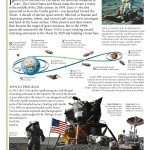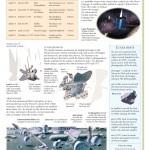People have dreamed of exploring the Moon for hundreds of years. The United States and Russia made the dream a reality in the middle of the 20th century. In 1959, Luna 1- the first spacecraft to leave the Earth’s gravity – was launched toward the Moon. A decade of intense space activity followed as Russian and American probes, robots, and crewed craft were sent to investigate and land on the lunar surface.
The Clementine space mission, launched in 1994, and Lunar Prospector, launched in 1998, found evidence that water ice is hidden in shadowed craters in the Moon’s Polar regions. The ice probably comes from comets that crashed into the Moon long ago. It could be either melted to supply a future Moon base with water, or broken down into oxygen for astronauts to breathe and into hydrogen for rocket fuel.
Related posts:
Radio waves are the same type of waves as light. They have less energy than visible light and so have a longer wavelength, but they travel at the same speed as light. At night our eyes and optical telescopes sees light from stars. But normal stars only produce radio waves very weakly.
The process of existence or initiative of life in the Solar System looks very interesting. Life in the solar system is a monomeric nucleotide, pretty much just a simple molecular compound made out of a normal, every-day inorganic material. Life started in the Earth once the things inside it are cooled down a bit. Basically life in the Earth is a replicator, the way it just happened or formed. Life...
Home galaxy of Earth, the Milky way is a spiral – shaped system of a few hundred billion stars. Bright regions of recently formed stars highlight its arms, while older stars explode or expel their outer layers as beautiful planetary nebulae, then fade away and die. A thick swarm of orange and red stars marks the galactic bulge, encapsulating the star-packed galactic center.
When the American Space program finally achieved a Moon landing on July 20, 1969, the Apollo 11 spacecraft was launched by a powerful rocked called Saturn V. The most powerful rocker ever, Saturn V was used to launch all the Apollo Spacecraft on lunar missions.
The oldest star chart known may be a carved ivory Mammoth tusk that was discovered in Germany in 1979. This artifact is 32,500 years old and has a carving that resembles the constellation Orion. A drawing on the wall of the Lascaux caves in France has a graphical representation of the Pleiades open cluster of stars.
Stellar advancement is the methodology by which a star experiences an arrangement of radical updates around its lifetime. Hinging on the mass of the star, this lifetime extends from just a few million years for the most gigantic to trillions of years for the slightest huge, which is impressively longer than the time period characterized by the universe. All stars are born from falling mists of...
A eclipse occurs when the Moon passes straight at the rear of the Earth into its umbra (shadow). This will happen only once the sun's rays, Earth, and Celestial satellite are aligned specifically, or extremely closely thus, using the World in the middle. Therefore, the eclipse can only occur the night time of your full-of-the-moon. The sort and also period of a great eclipse depend upon the Mo...
The Space shuttle bearer or the transporter flies return flights for the most part leave at day break or right away thereafter. Flying in the ballpark of 50 miles in front of it could be a pathfinder plane checking for climate unsettling influences and rerouteing the shuttle transporter if essential. In the ballpark of 30 group parts fly with the pathfinder and examine the shuttle for ha...
The Myers-Briggs Type Indicator (MBTI) assessment is a psychometric questionnaire designed to measure psychological preferences in how people perceive the world and make decisions. These preferences were extrapolated from the typological theories proposed by Carl Gustav Jung and first published in his 1921 book Psychological Types (English edition, 1923). Jung theorized that there are four pri...
If extraterrestrials were watching our TV shows, this is what they would be watching, depending on where they are in space. This concept is extremely interesting, because our TV shows are never lost, they are still being broadcasted in different areas of the universe. Waves travel nearly forever in space, unless an outside force acts on them.
Until 1838, Astronomers had little idea of the true size of the Universe. But in that year, Friedrich Bessel used a technique called the parallax method to make the first successful measurement of the distance to a star. Modern astronomers have many different ways of figuring out how far away an object is, but they all depend ultimately on the parallax method. As the Earth orbits the S...
Original person has an ambiguous temporal experience inside the box and becomes his double. Original person on undisturbed timeline decides to time- travel. He activates a time – delay device and leaves the area to avoid clashing with his double.
Saturn is the sixth planet from the Sun and the second most expansive planet in the Earth's planetary group, following Jupiter. Named following the Roman god Saturn, its galactic image (♄) speaks for the god's sickle. Saturn is a gas mammoth with a middle range something like nine times that of Earth. While one and only one-eighth the mean thickness of Earth, with its more impressive volume Sa...
Atomic theory is a theory of the nature of matter, which states that matter is composed of discrete units called atoms, as opposed to the obsolete notion that matter could be divided into any arbitrarily small quantity. The Atoms are subdivided into Nucleus. The Nucleus is formed with thousands of Nucleons. The Nucleons are again subdivided into Quarks. No matter how these are discovered, these di...
Polar Star utilizes four diverse strategies for electronic travel to defeat the challenges of towering-scope operations, and an electronic impetus control framework to finally administer six diesel-controlled impetus generators, several diesel-controlled send's utility generators, several impetus gas turbines, and different supplies fundamental to the smooth operation of the boat. The far reac...
The dominant features on the Moon’s nearside – the side that always faces the Earth – are the dark maria, which early astronomers thought were seas. These lava – filled basis formed when molten rock seeped through the Moon’s crust to fill depressions left by meteorite impacts.
The largest galaxies have nearly billion stars. There are an estimated billion stars in the milky way, our galaxy. If you tried to count all the stars in just our galaxy at a rat of one star per second, it would take you about 3000 years.
A planetary spacecraft has basic instruction programmed into its onboard computers at launch. However, most of the details are sent by controllers on Earth at a later stage, because journeys are often several years long. After discovering a problem with the radio transmissions between Cassini and Huygens, mission controllers were able to change their plans.



 Upload your infographic here and contribute to our community.
Upload your infographic here and contribute to our community. 
Leave a Reply